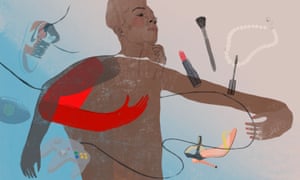
Colorism is more than being called a cockroach, having guys compare my nether regions to a medium rare steak, or seeing my crush preferring lighter-skinned women over me. No, it goes deeper than that. Colorism has programmed me to view myself as everything but beautiful, or even a woman.
Masculinity, ugliness and undesirability are traits that I have identified with since early adolescence. I was a tomboy, and being a dark-skinned black girl only added another layer to any discomfort I had regarding my appearance.
As a young teen, I was never comfortable wearing anything too feminine or skin-revealing. Hoodies, jeans, and sneakers were the only things in my closet. And yet, my bedroom was the opposite of this attitude: I had posters of the Jonas Brothers and the Twilight cast plastered over my walls, a large hot pink Hello Kitty blanket laid across my bed and a vast collection of Barbie and Bratz dolls. It was a stark contrast to the girl who mainly hung out with boys to play video games and football, and who liked riding bikes around Philadelphia.
Just like any other kid in the mid-2000s, I watched the Disney Channel religiously. The shows reinforced the notion that the white – or at least light – character was always the main protagonist, or the girl worthy of love. Shows with black casts also had a colorism problem: the Fresh Prince of Bel-Air and My Wife And Kids had replaced their dark-skinned female characters with lighter women, thinking no one would notice. Meet the Browns, Sister, Sister, The Proud Family, That’s So Ravenall had young black female characters that I loved but looked nothing like me. It made me question whether or not I could be deemed “girly” enough to ever be one of those girls who deserves a whirlwind romance.
As I got older, I began to feel more self-conscious. At 15, I wanted to be pretty and fit in with the other girls, but I didn’t know how or where to start. I began to watch YouTube makeup tutorials and wiggled myself more and more into the confines of what is considered feminine by wearing more and more makeup and being tedious about my hair (and I actually liked it).
I would wear long, straight weave, a full face of makeup – foundation, concealer, highlight, contour, heavily filled-in brows, lipstick. I would highlight most of my face with a lighter shade of concealer, essentially lightening my skin with makeup and masking who I really was. Soon, my performance began to feel like a resentful apology for having the type of skin society hated.
I was constantly in search of a balance that never even existed: “Maybe if I wear my hair straight I can look more feminine and wear less makeup. Maybe if I wear heels and go Nina Bo’nina Brown with my makeup I can get away with wearing my fro today.” I was viewing my features as something to trade in for one another, but it was always my skin tone that was the root of my problems.
Just in time to save me came the Black Lives Matter movement – in 2015, I decided to shave my hair off and go the extra mile with redefining black beauty for myself. I unlearned harmful stereotypes about black women, and learned how representation affects us psychologically. It finally dawned on me that the whitewashed media I had been consuming was reinforcing a form of femininity based on a European concept of womanhood – being fragile, dainty, submissive, soft – which was foreign to me. Having a high voice, long hair and more feminine clothing wasn’t something that I wanted to embrace any more.
The black women I grew up with had traits that would be considered masculine, quite the opposite of that European standard of femininity: they had rich voices and skin to match, an ability to be completely independent, a presence that compelled you to sit up straight and submit to them.
And even still, they would always make time to get their hair done, go to the nail salon, buy new heels and had an active love life. This was the brand of femininity that I had come to know and identify with because it has the best of both worlds: there was never any need to choose between being a mousy stay-at-home wife or being a greased-up blue-collar worker who worked until their hands bled.
What I had needed all along was right in front of me: my mom, my aunts, my grandmother, all self-sufficient and respected women who knew how to defend and care for themselves, never needing a man for anything unless it was to pull out their chair at dinner. This unique form of beauty, this duality, is the very essence of black womanhood.
[“source=theguardian”]
